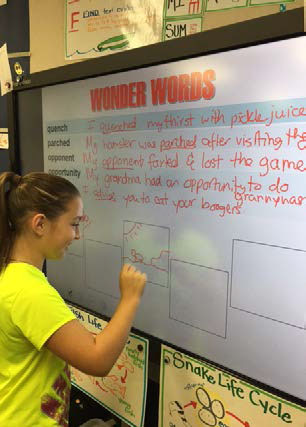Back Office Business

INTERACTIVE TOUCH PANELS GIVE ALL STUDENTS A VOICE
Cypress-Fairbanks ISD is the third largest district in Texas, covering 186 square miles and serving 115,000 students. To provide the district with the technology it needed, the community voted in favor of a $1.2 billion bond to help transform the district’s classrooms; $127 million of the funds from that bond were earmarked for instructional technology, which included interactive panels.
The bond committee approved the panel purchase because panels last longer than projectors and don’t require costly bulb replacements, says Becky Cook, the director of instructional technology at Cypress-Fairbanks. The district bought more than 7,000 Promethean ActivPanels and has been installing 300 a month—some mounted on walls and others on rolling stands to allow for greater mobility.
Cook says the district liked that the Multi-Touch ActivPanels allow students and teachers to collaborate in real time. She says that ClassFlow, the lesson-building software that comes with the ActivPanels, seamlessly connects students’ devices to the ActivPanels.
“Kids love being able to go up and touch the board,” says Cook, “and they love that there’s more than one touch.” Cook sees the combination of ActivPanels and ClassFlow as an “open-ended way to engage all students.” With all of the opportunities for collaboration, she says, “Even shy students have a voice now.”
ONLINE STUDY TOOL IMPROVES SOCIAL STUDIES TEST SCORES

When Springboro High School, a public school near Dayton, Ohio, introduced Chromebook laptops into most of the school’s classrooms, they added McGraw-Hill Education’s “United States Government: Our Democracy” online study tool, LearnSmart, as part of the expanded online library of resources.
Tech & Learning Newsletter
Tools and ideas to transform education. Sign up below.
“We were going through the process of picking new textbooks,” recalls social studies teacher Kelsie Andrews. “I thought adding LearnSmart as a study tool would give my students and their parents extra confidence, because its questions are triggered by what a student already knows.” LearnSmart uses adaptive technology to identify areas that need more study and helps students become more familiar with the content.
After implementing LearnSmart, Andrews reported an immediate increase in her students’ test results. “LearnSmart helps prepare students for the structure of tests as much as the content,” she says. “When students are familiar with the ways tests can be worded or set up, they aren’t thrown off by the testing itself. Before LearnSmart, my general students were averaging around 71 percent on all tests. After LearnSmart, they earned an average of 84 percent. None of those students had ever received anything above 80 percent before.”
HENRY COUNTY (GA) BOARD OF EDUCATION SHIFTS TOWARD PERSONALIZED LEARNING

Georgia’s ninth largest district will utilize BrightBytes’ Clarity platform to evaluate and quantify outcomes of personalized learning investments, empowering educators with actionable insights to inform teaching and learning. This is an expansion of a multi-year partnership in support of the district’s efforts to scale high-quality, personalized learning through an eight-year initiative that will utilize 36,000 devices to create a 1:1 computing environment across grades 3–12. Although the Henry County Board of Education, located just south of Atlanta, has embraced the role of technology in a transformation designed to better prepare an increasingly diverse student body, the district’s personalized learning plans are rooted in the application of research-based insights to enable great teaching—and an intense commitment to student agency. BrightBytes’ platform was selected, in part, due to its ability to measure and report on dimensions of student growth and success that extend beyond traditional academic factors. To date, 32 of the district’s 50 schools have begun implementation of personalized learning initiatives as part of an eight-year school redesign project. The district expects to complete implementation and evaluation of personalized learning programs in all of its schools by 2020.
UPPER GRAND DISTRICT SCHOOL BOARD TRANSFORMS K–12 LEARNING WITH DREMEL 3D PRINTERS

Looking to the future with a focused commitment on community engagement, 90 schools in the Guelph, Ontario suburb have successfully integrated 3D printers into their curricula. All it took was the purchase of one 3D printer to convince technological leader for Upper Grand District School Board, Charles Benyair, that the new technology is integral to the future of his students and the community at large. Just two years after buying its first printer, the district has evolved to host a full network of over one hundred Dremel 3D printers. Curricula have been modified in every subject area, programs encourage students to build parts needed by the local community, and trained teachers have become experts. The district worked with Advanced Education, a tech integrator that also provided professional development so educators could integrate the 3D printers into their curricula effectively.
“Our strategy is to help kids understand problem-solving skills and truly grasp the potential that 3D printers have to contribute to a solution,” Benyair says. “We take some K–12 students out into the schoolyard and pose issues to them, and they in turn design solutions for them with the necessary software and printer. For example, we had students design picnic table plugs that seal up the umbrella holes in the winter when they aren’t being used. Each month, and each year, the problems will change and the students will have to react to real-world problems.” Since implementing 3D printers into their curricula, the average percentage of students taking a technology class grew to 40 percent, which is 10 percent above the national average. “We really appreciate the SHSM’s support to fund this endeavor that, in two short years, has transformed our classrooms,” Benyair says. “Our students are all mini-engineers, which opens up a realm of possibilities for them as they continue to develop.”
